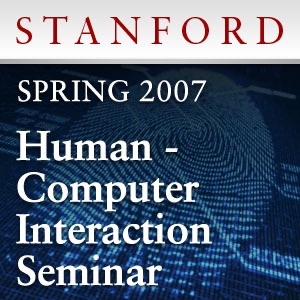Discover Human-Computer Interaction Seminar (Spring 2007)
Human-Computer Interaction Seminar (Spring 2007)

Human-Computer Interaction Seminar (Spring 2007)
Author: Stanford University
Subscribed: 0Played: 0Subscribe
Share
Description
Weekly speakers on topics related to human-computer interaction design. Presentations on a wide and evolving range of current research issues relating to human-computer interaction.
9 Episodes
Reverse
Bill Buxton discusses the design process itself, from the perspective of methods, organization, and composition. Fundamental to our approach is the notion that sketching is a fundamental component of design. (June 1, 2007)
Joe Britt discusses several key aspects of the platform¹s development and share the design philosophy applied by the team. (May 25, 2007)
Wendy Ju outlines implicit interactions as an emerging area of applied design research that investigates the design of implicit interactions, which occur without the behest or awareness of the user. (May 18, 2007)
Knowledge media were anticipated although not named as such in seminal papers by Vannevar Bush in 1945 and JCR Licklider in 1960. This talk reviews 40 years (1966-2006) of Ron Baecker's work in the design of knowledge media. (May 4, 2007)
Human-Computer Interaction sits at the boundary between technical and social practice. Unlike entirely technical disciplines, we cannot always evaluate our work on clearly defined criteria such as bits-per-second or megahertz. (April 27, 2007)
Prototypes are an effective way of communicating. But communicating what precisely? This talk explores the role of different types of prototypes in researching and designing interactive artifacts. (April 20, 2007)
The eyes are a rich source of information for gathering context in our everyday lives. Using eye-gaze information as a form of input can enable a computer system to gain more contextual information about the user's task. (April 13, 2007)
Proactive computing offers many desired benefits to users, such as enabling a high degree of awareness of peripheral information. However, notifications from proactive systems run the serious risk of interrupting users’ tasks. (April 6, 2007)





